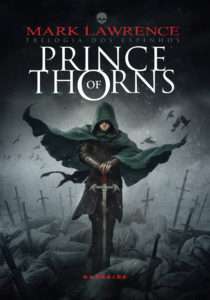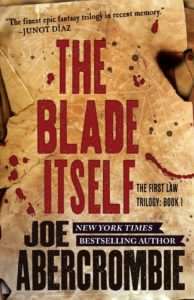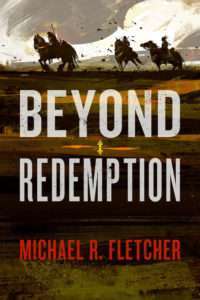Adrian Collins's Blog, page 132
July 3, 2022
REVIEW: Pan’s Labyrinth
Fairy tales are seen as the foundation for fantasy – the source of magical, fantastical stories that have been told for centuries. They are tales told to make sense of the world around us; tales that provide hope in dark times, or offer us coping mechanisms when overwhelmed. Guillermo Del Toro’s Pan’s Labyrinth is a dark fantasy film that weaves fantasy and magic with the horrors of the Franco’s Spain and in doing so, he created one of the darkest and most beautiful films ever made.
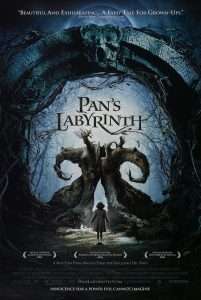 Pan’s Labyrinth follows 11-year-old Ofelia, a young girl living between two worlds. It is 1944 in Spain and Captain Vidal has been ordered to move to a village and rout out a band of rebels. Ofelia hates Vidal who is married to her pregnant mother and witnesses the nonchalant way he shoots dead two innocent farmers. Ofelia follows a preying mantis she believes to be a fairy and winds up in a stunning labyrinth with a terrifyingly strange faun. The faun believes Ofelia is a reincarnated princess and gives her a book with three tasks that he says she needs to complete to return to her kingdom. The story flits between Vidal’s fight against the rebels and Ofelia’s journey into fantasy with horrors on both sides. The sadist Vidal shows viewers how true horror exists in the real world whilst Ofelia learns the importance of the choices she makes as she comes face to face with terrifying creatures such as the haunting Pale Man. This is no children’s fairy tale. It is a powerful story that will live long in the memory of any who watch it.
Pan’s Labyrinth follows 11-year-old Ofelia, a young girl living between two worlds. It is 1944 in Spain and Captain Vidal has been ordered to move to a village and rout out a band of rebels. Ofelia hates Vidal who is married to her pregnant mother and witnesses the nonchalant way he shoots dead two innocent farmers. Ofelia follows a preying mantis she believes to be a fairy and winds up in a stunning labyrinth with a terrifyingly strange faun. The faun believes Ofelia is a reincarnated princess and gives her a book with three tasks that he says she needs to complete to return to her kingdom. The story flits between Vidal’s fight against the rebels and Ofelia’s journey into fantasy with horrors on both sides. The sadist Vidal shows viewers how true horror exists in the real world whilst Ofelia learns the importance of the choices she makes as she comes face to face with terrifying creatures such as the haunting Pale Man. This is no children’s fairy tale. It is a powerful story that will live long in the memory of any who watch it.
Pan’s Labyrinth is visually stunning. Del Toro’s skill being the camera is almost unmatched and his use of practical effects give a raw power to the fantasy elements as we follow Ofelia on her haunting journey. There is a darkness to the story throughout but there are powerful moments laced throughout where various characters continue a fight fueled only by glimmers of hope and this is something that makes grimdark so effective. Doug Jones (The Shape of Water, Hellboy) gives a powerful, unnerving performance as both the Pale Man and the titular faun whilst Sergi Lopez steals every scene he is in as the inhumane Vidal. Every part of the film from its direction, script, and music is put together with love and care – something Del Toro fans have come to expect from the master filmmaker. It is a film that demands multiple viewings though the subject matter and gory scenes of mutilation may be difficult for some.
Pan’s Labyrinth is a masterful dark fantasy film by one the world’s greatest filmmakers. This is a fairy tale for grown-ups. It is a film that asks you to witness the dark depths of both fantasy and humanity and never before has such a journey been so stunningly beautiful. It is a timeless classic that has set a high bar that most fantasy films will struggle to reach.
The post REVIEW: Pan’s Labyrinth appeared first on Grimdark Magazine.
Grimdark Fantasy: Where to start reading
Ask ten grimdark fantasy fans what their definition of grimdark is, and you’re likely to get ten marginally, if not wildly, different answers. However, ask them for a top ten list, and you can all but guarantee the same tall stack of male authors will dominate.
When I sat down (virtually) with the leaders of the Grimdark Magazine review team to build this list, we agreed upon a few things:
Try as we might have over the last eight years, the “definitively defining the subgenre” horse has long bolted. We couldn’t control it. You can’t control it. We’re going to piss off somebody with this list–let’s just get on with it.Few publishers nowadays want the books they put out shoehorned into “grimdark fantasy”. They tried it in the 2010’s, it didn’t work out as a marketing term for too many authors, and it’s been popped back on the shelf at a Big 4 level. That’s okay, we can all still love books that meet our definitions of grimdark without the Hachette marketing department flying the grimdark flag and pinning an author’s career on it.The grimdark fantasy subgenre has changed from a standard list of blokes from the 80’s and 90’s and 2000’s, with new voices and new authors injecting perspectives and ideas more vicious and well written than their contemporaries, and those people need to make up a decent chunk of a list written in the 2020’s.Having agreed upon that, Beth, James, Fabienne, David, and I entered into weeks of arguments over what would fit into our modern grimdark must read list. We have done our best to both keep it relatively short, and to both do justice to those that laid the path, and those who now walk it.
We give you, in no particular order of preference, Grimdark Magazine’s where to start reading grimdark list.
The Poppy War by R.F. Kuang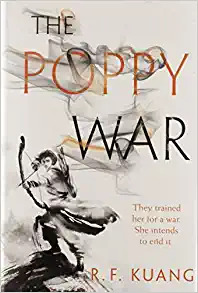 This is a book that gets under your skin, and it left me equal parts haunted, transfixed, and overwhelmingly glad my standardized testing days are behind me.
This is a book that gets under your skin, and it left me equal parts haunted, transfixed, and overwhelmingly glad my standardized testing days are behind me.
Read the full review here.
About the bookWhen Rin aced the Keju—the Empire-wide test to find the most talented youth to learn at the Academies—it was a shock to everyone: to the test officials, who couldn’t believe a war orphan from Rooster Province could pass without cheating; to Rin’s guardians, who believed they’d finally be able to marry her off and further their criminal enterprise; and to Rin herself, who realized she was finally free of the servitude and despair that had made up her daily existence. That she got into Sinegard—the most elite military school in Nikan—was even more surprising.
But surprises aren’t always good.
Because being a dark-skinned peasant girl from the south is not an easy thing at Sinegard. Targeted from the outset by rival classmates for her color, poverty, and gender, Rin discovers she possesses a lethal, unearthly power—an aptitude for the nearly-mythical art of shamanism. Exploring the depths of her gift with the help of a seemingly insane teacher and psychoactive substances, Rin learns that gods long thought dead are very much alive—and that mastering control over those powers could mean more than just surviving school.
For while the Nikara Empire is at peace, the Federation of Mugen still lurks across a narrow sea. The militarily advanced Federation occupied Nikan for decades after the First Poppy War, and only barely lost the continent in the Second. And while most of the people are complacent to go about their lives, a few are aware that a Third Poppy War is just a spark away . . .
Rin’s shamanic powers may be the only way to save her people. But as she finds out more about the god that has chosen her, the vengeful Phoenix, she fears that winning the war may cost her humanity . . . and that it may already be too late.
Read The Poppy War by R.F. KuangPrince of Thorns by Mark LawrencePrince of Thorns is one of the best and most influential books in grimdark fantasy, authored by one of the founding fathers of the genre.
Read the full review here.
About the bookBefore the thorns taught me their sharp lessons and bled weakness from me I had but one brother, and I loved him well. But those days are gone and what is left of them lies in my mother’s tomb. Now I have many brothers, quick with knife and sword, and as evil as you please. We ride this broken empire and loot its corpse. They say these are violent times, the end of days when the dead roam and monsters haunt the night. All that’s true enough, but there’s something worse out there, in the dark. Much worse.
From being a privileged royal child, raised by a loving mother, Jorg Ancrath has become the Prince of Thorns, a charming, immoral boy leading a grim band of outlaws in a series of raids and atrocities. The world is in chaos: violence is rife, nightmares everywhere. Jorg has the ability to master the living and the dead, but there is still one thing that puts a chill in him. Returning to his father’s castle Jorg must confront horrors from his childhood and carve himself a future with all hands turned against him.
Mark Lawrence’s debut novel tells a tale of blood and treachery, magic and brotherhood and paints a compelling and brutal, and sometimes beautiful, picture of an exceptional boy on his journey toward manhood and the throne.
Read Prince of Thorns by Mark LawrenceRemote Control by Nnedi Okorafor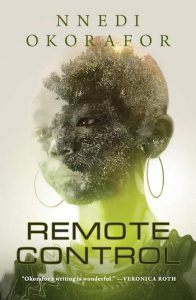 The ending is like a warm, loving, grimdark slap in the face. It comes out of nowhere and it works brilliantly and everything leads to it and I loved it. It’s a brilliant twist where all the learning, the lack of control over her life and her power, all comes full circle in just a few brilliant paragraphs that had my jaw flopping on the floor.
The ending is like a warm, loving, grimdark slap in the face. It comes out of nowhere and it works brilliantly and everything leads to it and I loved it. It’s a brilliant twist where all the learning, the lack of control over her life and her power, all comes full circle in just a few brilliant paragraphs that had my jaw flopping on the floor.
Read the rest of the review here.
About the bookThe day Fatima forgot her name, Death paid a visit. From hereon in she would be known as Sankofa—-a name that meant nothing to anyone but her, the only tie to her family and her past.
Her touch is death, and with a glance a town can fall. And she walks–alone, except for her fox companion–searching for the object that came from the sky and gave itself to her when the meteors fell and when she was yet unchanged; searching for answers.
But is there a greater purpose for Sankofa, now that Death is her constant companion?
Read Remote Control by Nnedi OkoraforThe Blade Itself by Joe AbercrombieA brilliant, complex world with morally grey characters and ever on going wars, The Blade Itself truly reminds me of what a joy it is to read a gritty, dark fantasy.
Read the rest of the review here.
About the bookInquisitor Glokta, a crippled and bitter relic of the last war, former fencing champion turned torturer, is trapped in a twisted and broken body – not that he allows it to distract him from his daily routine of torturing smugglers.
Nobleman, dashing officer and would-be fencing champion Captain Jezal dan Luthar is living a life of ease by cheating his friends at cards. Vain and shallow, the biggest blot on his horizon is having to get out of bed in the morning to train with obsessive and boring old men. And Logen Ninefingers, an infamous warrior with a bloody past, is about to wake up with plans to settle a blood feud with Bethod, the new King of the Northmen, once and for all – ideally by running away from it.
But as he’s discovering, old habits die hard….especially when Bayaz gets involved. An old man with a terrible temper and a pathetic assistant, he could be the First of the Magi, he could be a spectacular fraud, but whatever he is, he’s about to make the lives of Glokta, Jezal, and Logen a whole lot more difficult….
Read The Blade Itself by Joe AbercrombieThe Court of Broken Knives by Anna Smith Spark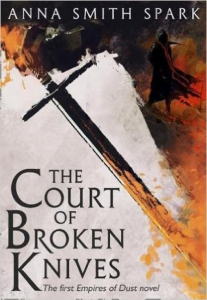 Cover to cover The Court of Broken Knives isn’t just a good read, it’s an experience. For me, it was pretty much un-put-downable. It was lightning-paced, beautiful, deep, haunted, violent, gripping, gritty AF, and exactly what what I wanted.
Cover to cover The Court of Broken Knives isn’t just a good read, it’s an experience. For me, it was pretty much un-put-downable. It was lightning-paced, beautiful, deep, haunted, violent, gripping, gritty AF, and exactly what what I wanted.
Read the full review here.
About this bookThey’ve finally looked at the graveyard of our empire with open eyes. They’re fools and madmen and like the art of war. And their children go hungry while we piss gold and jewels into the dust.
In the richest empire the world has ever known, the city of Sorlost has always stood, eternal and unconquered. But in a city of dreams governed by an imposturous emperor, decadence has become the true ruler and has blinded its inhabitants to their vulnerability. The empire is on the verge of invasion – and only one man can see it.
Haunted by dreams of the empire’s demise, Orhan Emmereth has decided to act. On his orders, a company of soldiers cross the desert to reach the city. Once they enter the palace, they have one mission: kill the emperor, then all those who remain. Only from ashes can a new empire be built.
The company is a group of good, ordinary soldiers for whom this is a mission like any other. But the strange boy Marith who walks among them is no ordinary soldier. Marching on Sorlost, Marith thinks he is running away from the past which haunts him. But in the Golden City, his destiny awaits him – beautiful, bloody, and more terrible than anyone could have foreseen.
Read The Court of Broken Knives by Anna Smith SparkBlackwing by Ed McDonald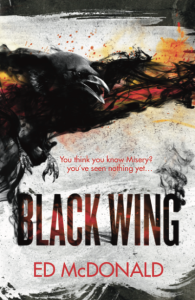 Blackwing was one of the best grimdark debuts of 2017.
Blackwing was one of the best grimdark debuts of 2017.
Read our full review here.
About this bookThe republic faces annihilation, despite the vigilance of Galharrow’s Blackwings. When a raven tattoo rips itself from his arm to deliver a desperate message, Galharrow and a mysterious noblewoman must investigate a long-dead sorcerer’s legacy. But there is a conspiracy within the citadel: traitors, flesh eaters and the ghosts of the wastelands seek to destroy them, but if they cannot solve the ancient wizard’s paradox, the Deep Kings will walk the earth again, and all will be lost.
The war with the Eastern Empire ended in stalemate some 80 years ago thanks to Nall’s Engine, a wizard-crafted weapon so powerful even the Deep Kings feared it. The strike of the engine created the Misery – a wasteland full of ghosts and corrupted magic that now forms a no-man’s-land along the frontier. But when Galharrow investigates a frontier fortress, he discovers complacency bordering on treason: then the walls are stormed, and the engine fails to launch.
Galharrow escapes only because of the preternatural magical power of the noblewoman he was supposed to be protecting. Together they race to the capital to unmask the traitors and restore the republic’s defences. Far across the Misery, a vast army is on the move, as the empire prepares to call the republic’s bluff.
Read Blackwing by Ed McDonaldGodblind by Anna Stephens Godblind is a fast-paced and merciless tale. If you like multiple POV characters and good fight scenes, and you have a solid constitution, you’ll enjoy this book.
Godblind is a fast-paced and merciless tale. If you like multiple POV characters and good fight scenes, and you have a solid constitution, you’ll enjoy this book.
Read the rest of this review here.
About this bookThere was a time when the Red Gods ruled the land. The Dark Lady and her horde dealt in death and blood and fire.
That time has long since passed, and the neighbouring kingdoms of Mireces and Rilpor hold an uneasy truce. The only blood spilled is confined to the border, where vigilantes known as Wolves protect their kin and territory at any cost.
But after the death of his wife, King Rastoth is plagued by grief, leaving the kingdom of Rilpor vulnerable. Vulnerable to the bloodthirsty greed of the Warrior-King Liris and the Mireces army waiting in the mountains…
Read Godblind by Anna StephensPriest of Bones by Peter McLean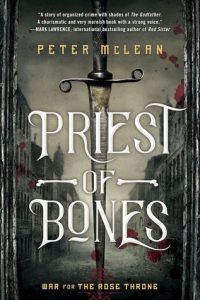 With its fast-moving plot, intense conflicts, interesting characters, and compelling narrative, Priest of Bones is sure to be among the favourite reads for grimdark fantasy fans this year.
With its fast-moving plot, intense conflicts, interesting characters, and compelling narrative, Priest of Bones is sure to be among the favourite reads for grimdark fantasy fans this year.
Read the rest of the review here.
About this book‘Sixty-five thousand battle-shocked, trained killers came home to no jobs, no food and the plague. What did Her Majesty think was going to happen?’
Tomas Piety takes his duties seriously: as a soldier, as a priest of Our Lady of Eternal Sorrows and as a leader of men. He has come home from the war to reclaim his family business, to provide for his men and to ensure the horrors of Abingon can never happen in Ellinburg.
But things have changed: his crime empire has been stolen, and the people of Ellinburg – his people – have run out of food and hope and places to hide. With his best friend, Bloody Anne, his war-damaged brother, Jochan, and his new gang, the Pious Men, Tomas sets out to reclaim what was his.
And as Tomas is dragged into a web of political intrigue by the sinister Queen’s Men, forced to work against the foreign infiltrators lurking in the backstreet taverns, brothels and gambling dens of the Stink, one thing becomes clear.
The war has just begun.
Read Priest of Bones by Peter McLeanMirror Empire by Kameron Hurley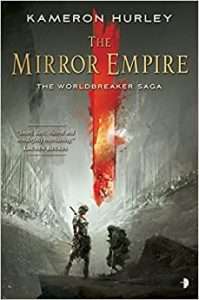 About as grimdark as fantasy literature can get.
About as grimdark as fantasy literature can get.
On the eve of a recurring catastrophic event known to extinguish nations and reshape continents, a troubled orphan evades death and slavery to uncover her own bloody past – while a world goes to war with itself. In the frozen kingdom of Saiduan, invaders from another realm are decimating whole cities, leaving behind nothing but ash and ruin.
As the dark star of the cataclysm rises, an illegitimate ruler is tasked with holding together a country fractured by civil war, a precocious young fighter is asked to betray his family and a half-Dhai general must choose between the eradication of her father’s people or loyalty to her alien Empress.
Through tense alliances and devastating betrayal, the Dhai and their allies attempt to hold against a seemingly unstoppable force as enemy nations prepare for a coming together of worlds as old as the universe itself. In the end, one world will rise – and many will perish.
Read Mirror Empire by Kameron HurleyThe Builders by Daniel Polansky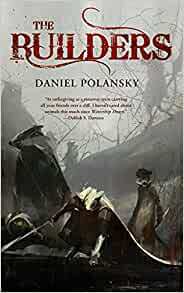 One of the best pieces of fiction I’ve read in 2017, the Builders is a masterclass in character and story and world. Betrayal, tough as all hell characters, a little flavouring of grit and a glut of unsavoury characters working towards an unsavoury goal–this has everything I and any GdM fan could want.
One of the best pieces of fiction I’ve read in 2017, the Builders is a masterclass in character and story and world. Betrayal, tough as all hell characters, a little flavouring of grit and a glut of unsavoury characters working towards an unsavoury goal–this has everything I and any GdM fan could want.
A missing eye. A broken wing. A stolen country. The last job didn’t end well. Years go by, and scars fade, but memories only fester. For the animals of the Captain’s company, survival has meant keeping a low profile, building a new life, and trying to forget the war they lost. But now the Captain’s whiskers are twitching at the idea of evening the score.
Read The Builders by Daniel PolanskyGideon the Ninth by Tamsyn Muir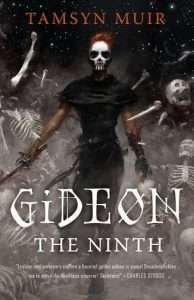 In a world of necromancers, animated skeletons and wide-ranging bone magic, a cynical lesbian with a sword, a strong arm and a sharp wit just makes so much sense. This might not be for everyone, and certainly rewards a little patience, but for those willing to relax into it, there’s a lot to enjoy.
In a world of necromancers, animated skeletons and wide-ranging bone magic, a cynical lesbian with a sword, a strong arm and a sharp wit just makes so much sense. This might not be for everyone, and certainly rewards a little patience, but for those willing to relax into it, there’s a lot to enjoy.
Read the rest of the review here.
About this bookThe Emperor needs necromancers.
The Ninth Necromancer needs a swordswoman.
Gideon has a sword, some dirty magazines, and no more time for undead nonsense.
Tamsyn Muir’s Gideon the Ninth unveils a solar system of swordplay, cut-throat politics, and lesbian necromancers. Her characters leap off the page, as skillfully animated as arcane revenants. The result is a heart-pounding epic science fantasy.
Brought up by unfriendly, ossifying nuns, ancient retainers, and countless skeletons, Gideon is ready to abandon a life of servitude and an afterlife as a reanimated corpse. She packs up her sword, her shoes, and her dirty magazines, and prepares to launch her daring escape. But her childhood nemesis won’t set her free without a service.
Harrowhark Nonagesimus, Reverend Daughter of the Ninth House and bone witch extraordinaire, has been summoned into action. The Emperor has invited the heirs to each of his loyal Houses to a deadly trial of wits and skill. If Harrowhark succeeds she will be become an immortal, all-powerful servant of the Resurrection, but no necromancer can ascend without their cavalier. Without Gideon’s sword, Harrow will fail, and the Ninth House will die.
Of course, some things are better left dead.
Read Gideon the Ninth by Tamsyn MuirChasing Graves by Ben Galley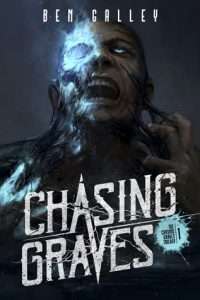 Quintessential grimdark fantasy.
Quintessential grimdark fantasy.
Read the rest of the review here.
About this bookMeet Caltro Basalt. He’s a master locksmith, a selfish bastard, and as of his first night in Araxes, stone-cold dead.
They call it the City of Countless Souls, the colossal jewel of the Arctian Empire, and all it takes to be its ruler is to own more ghosts than any other. For in Araxes, the dead do not rest in peace in the afterlife, but live on as slaves for the rich.
While Caltro struggles to survive, those around him strive for the emperor’s throne in Araxes’ cutthroat game of power. The dead gods whisper from corpses, a soulstealer seeks to make a name for himself with the help of an ancient cult, a princess plots to purge the emperor from his armoured Sanctuary, and a murderer drags a body across the desert, intent on reaching Araxes no matter the cost.
Only one thing is certain in Araxes: death is just the beginning.
Read Chasing Graves by Ben GalleyWe ride the storm by Devin Madson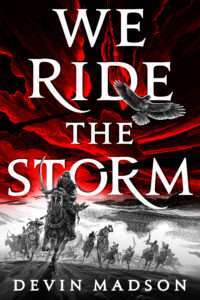 When We Ride the Storm by Devin Madison opened with the line, “It’s harder to sever a head than people think. Perhaps if one were skilled with an axe it could be done in a single blow—so long as the body was not trying to run away at the time” I knew I’d found something truly special.
When We Ride the Storm by Devin Madison opened with the line, “It’s harder to sever a head than people think. Perhaps if one were skilled with an axe it could be done in a single blow—so long as the body was not trying to run away at the time” I knew I’d found something truly special.
Read the rest of the review here.
About this bookAS AN EMPIRE DIES, THREE WARRIORS WILL RISE. THEY MUST RIDE THE STORM OR DROWN IN ITS BLOOD.
The kingdom of Kisia is divided, held together only by the will of the god-emperor. When an act of betrayal shatters an alliance with the neighbouring land of Chiltae, all that has been won comes crashing down.
Now, as the fires of war spread, a warrior, an assassin and a princess must chase their ambitions, no matter the cost.
War built the Kisian Empire. And now war will tear it down.
Read We ride the storm by Devin MadsonA Crown for Cold Silver by Alex Marshall" target="_blank" rel="noopener">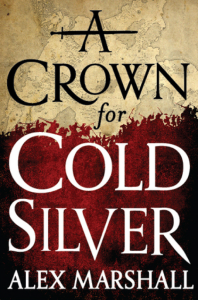 A tale so full of grit, dark humour, drugs, fuck-ups, and excellent writing that straight off the bat I’m not afraid to say it was one of my favourite reads for 2015.
A tale so full of grit, dark humour, drugs, fuck-ups, and excellent writing that straight off the bat I’m not afraid to say it was one of my favourite reads for 2015.
Read the rest of the review here.
About this bookCold Cobalt, the Banshee with a Blade, First Among Villains . . . Queen Zosia
When there were no more titles to win and no more worlds to conquer, the warrior queen Zosia faked her demise and gave up her legend to history. But when violence finds its way to her door years later, she must round up her adventuring companions – each surprised to see her alive – and set out for revenge.
Time has not been kind to her old comrades, and some have only their own goals in mind. Not only that, but there’s a young, beautiful and skilled general out there, gathering soldiers to her banner for a war against the deadliest of enemies. The girl is using a legend she did not earn, and calling herself by a name that was never hers – that of Zosia herself.
Read A Crown for Cold Silver by Alex MarshallBeyond Redemption by Michael R. FletcherMany of the elements in the story are those we’ve seen before: an aged barbarian at the end of his stamina, a cocky swordsman, a religious nut greedy for power and self preservation. But Fletcher has taken these classic tropes and given them new, psychotic life.
Read the rest of the review here.
About this bookFaith shapes the landscape, defines the laws of physics, and makes a mockery of truth. Common knowledge isn’t an axiom, it’s a force of nature. What the masses believe is. But insanity is a weapon, conviction a shield. Delusions give birth to foul new gods.
Violent and dark, the world is filled with the Geisteskranken–men and women whose delusions manifest, twisting reality. High Priest Konig seeks to create order from chaos. He defines the beliefs of his followers, leading their faith to one end: a young boy, Morgen, must Ascend to become a god. A god they can control.
But there are many who would see this would-be-god in their thrall, including the High Priest’s own Doppels, and a Slaver no one can resist. Three reprobates–The Greatest Swordsman in the World, a murderous Kleptic, and possibly the only sane man left–have their own nefarious plans for the young god.
As these forces converge on the boy, there’s one more obstacle: time is running out. When one’s delusions become more powerful, they become harder to control. The fate of the Geisteskranken is to inevitably find oneself in the Afterdeath. The question, then, is:
Who will rule there?
Read Beyond Redemption by Michael R. FletcherThe Grim Company by Luke Scull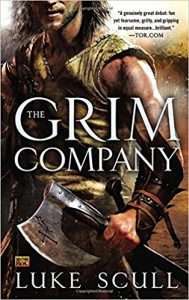 A classic of the genre that every budding grimdark fantasy fan should read.
A classic of the genre that every budding grimdark fantasy fan should read.
Read the rest of the review here.
About this bookThe difference between a hero and a killer lies in the ability to justify dark deeds. But this is the Age of Ruin. And there are no heroes…
Five hundred years ago, the world was destroyed in the celestial Godswar. Seeking to throw off the shackles of the deities who created them, a cabal of mages rose up and made war upon the Gods. Though they won out, it was at a great cost: the ensuing cataclysm brought forth the Age of Ruin to the world.
Five hundred years later, the world limps on, seemingly winding down to an inevitable end. Dystopian city states have arisen, each presided over by one of the Magelords who first made war.
Corrupted, near-immortal, and far too powerful, those wizards who once sought to free the world now make war upon each other, while the helpless populace limp on from day to day.
Into this blighted world, steps Davarus Cole, a boy obsessed with notions of heroism and adventuring, who burns to do great deeds. One night, in a reckless act, Cole gets himself into a brawl with the authories. He quickly finds himself sent away from the city, where the world still groans from the ancient cataclysm, and the corpses of Gods lie deep beneath the bedrock, leaking wild, uncontrolled magic into the world.
Read The Grim Company by Luke ScullThe Darkness that Comes Before by R. Scott Bakker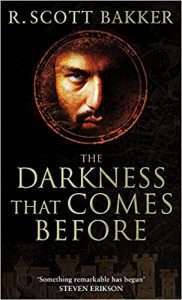 Lodged under the grimdark label, The Darkness That Comes Before is not for the faint of heart. Bakker’s setup warns this is only the beginning of a full descent into darkness. His exploration of choice and the fallout from those decisions adds a relevant and meaningful layer into his intentions with the novel: “It’s the concert of knowledge and ignorance that underwrites our decisions”
Lodged under the grimdark label, The Darkness That Comes Before is not for the faint of heart. Bakker’s setup warns this is only the beginning of a full descent into darkness. His exploration of choice and the fallout from those decisions adds a relevant and meaningful layer into his intentions with the novel: “It’s the concert of knowledge and ignorance that underwrites our decisions”
Read the rest of the review here.
About this bookA score of centuries has passed since the First Apocalypse and the thoughts of men have turned, inevitably, to more worldly concerns…A veteran sorcerer and spy seeks news of an ancient enemy. A military genius plots to conquer the known world for his Emperor but dreams of the throne for himself. The spiritual leader of the Thousand Temples seeks a Holy War to cleanse the land of the infidel. An exiled barbarian chieftain seeks vengeance against the man who disgraced him. And into this world steps a man like no other, seeking to bind all – man and woman, emperor and slave – to his own mysterious ends. But the fate of men – even great men – means little when the world itself may soon be torn asunder. Behind the politics, beneath the religious fervour, a dark and ancient evil is reawakening. After two thousand years, the No-God is returning. The Second Apocalypse is nigh. And one cannot raise walls against what has been forgotten…
Read The Darkness that Comes Before by R. Scott BakkerA note on Game of ThronesI think it needs to be acknowledged that Game of Thrones by George R.R. Martin is not on this list. Martin has led the charge with grimdark fantasy for a long, long time. His books being turned into a a TV series has drawn in so many new readers, viewers, and just generally interested people, that his impact can likely not be accurately measured–beyond it being fucking massive. However, it has been a good while since we’ve seen new black and white pages from the godfather of grimdark, and therefore, we’ve opted to go with newer (in some cases “ish”) authors. From an author who creates so many anthologies and the like to promote other people, I think he’d be alright with that decision.
The post Grimdark Fantasy: Where to start reading appeared first on Grimdark Magazine.
July 1, 2022
REVIEW: Earthlings by Sayaka Murata
See that cute stuffed hedgehog on the cover of Earthlings by Sayaka Murata? That’s Piyyut. He’s best friends with Natsuki, the book’s narrator, an 11-year-old girl who is also a self-described magician. As explained by Natsuki:
“I hugged my backpack to me. Inside it was my origami magic wand and my magical transformation mirror. At the very top of the backpack was my best friend, Piyyut, who gave me these magical objects. Piyyut can’t speak human since the evil forces put a spell on him, but he’s looking after me so I won’t get carsick.”
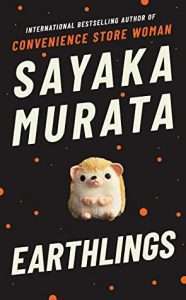 Natsuki goes on to explain that Piyyut isn’t actually a stuffed animal. He is an alien from the Planet Popinpobopia who has given Natsuki a special mission:
Natsuki goes on to explain that Piyyut isn’t actually a stuffed animal. He is an alien from the Planet Popinpobopia who has given Natsuki a special mission:
“The Magic Police had found out the Earth was facing a crisis and had sent him on a mission to save our planet. Since then I’d been using the powers he’d given me to protect the Earth.”
This is all very cute for a young child, right? It’s not so cute when Natsuki grows up and still believes even more firmly in these childhood fantasies.
Earthlings starts off with a lighthearted style and then descends very quickly into darkness. Some of the trigger warnings include child abuse, incest, murder, and cannibalism. It gets very dark, very fast.
Adult Natsuki has brought two other characters into her delusions: her cousin and her asexual husband. They are convinced that they are all aliens and are determined to be true to their Popinpobopian roots and reject human society, which they see as a conformist Baby Factory. Murata handles the themes of asexuality and anticonformity brilliantly in Earthlings, as she has done previously in her well-known novel, Convenience Store Woman.
Earthlings is very Japanese in its dark and quirky sense of humor and its combination of the kawaii (cute) and the obscene. I found Earthlings to be a unique and highly original read. The closest book I can compare this to is Kafka on the Shore by Haruki Murakami. But even that comparison is a stretch.
Sayaka Murata’s writing is perfect throughout Earthlings. Her writing style is a joy, even while the plot sinks deeper into insanity and obscenity.
Strangely enough, this is my fifth book this year with “surprise” cannibalism. Is this a new trend in publishing? At least Murata makes it sound more appealing than other authors:
“‘We’ll have a feast tonight!’ my husband cried happily. We prepared three Man dishes: Miso Soup with Man, Daikon Leaf and Man Stir-Fry, and Man Simmered in Sweetened Soy Sauce.”
Obviously, this book is not for everyone. But if you love quirky Japanese novels with a twisted and macabre sense of humor—coupled with deep insights about the conformist nature of human society—then you’ll probably appreciate Earthlings as much as I did.
4.5/5
Read Earthlings by Sayaka MurataThe post REVIEW: Earthlings by Sayaka Murata appeared first on Grimdark Magazine.
June 30, 2022
REVIEW: In the Night Wood by Dale Bailey
In the Night Wood is an ingeniously written Gothic horror novel by Dale Bailey, which serves as both a tribute to classic Gothic literature and a unique, riveting story in its own right.
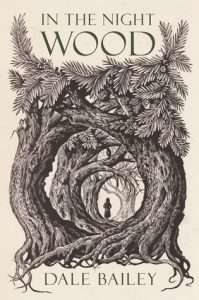 As the novel opens, the narrator, a boy named Charles Hayden, is strangely captivated by an obscure fairy tale, also called In the Night Wood, written by the enigmatic Victorian author Caedmon Hollow.
As the novel opens, the narrator, a boy named Charles Hayden, is strangely captivated by an obscure fairy tale, also called In the Night Wood, written by the enigmatic Victorian author Caedmon Hollow.
The story jumps ahead to Charles at graduate school, where Caedmon Hollow is the subject of his doctoral research. During a late-night study session, Charles literally bumps into the love of his life, Erin, at the university library. As fate would have it, Erin is a direct descendant of Caedmon Hollow. Charles promises to give her a “happily ever after,” and six months later they are married.
Fast forward another ten years, and Charles has lost his job as an English professor at Ransom College. Even worse, Charles and Erin’s only daughter, Lissa, has perished in an unspeakable tragedy. Their marriage is broken, and Erin is abusing prescription drugs to numb her pain. Charles and Erin move from America to the English countryside, where she has inherited the Hollow family estate.
Alongside the Hollow House is a dark forest curiously like that described in Caedmon Hollow’s fairy tale. The locals repeatedly warn Charles and Erin not to explore the woods, since people get lost there and never return.
Charles tries to overcome the grief of losing his daughter by throwing himself into his next academic project: an authoritative biography of Caedmon Hollow. He discovers many lost writings from the mysterious author, including a peculiar cipher that becomes a focal point of his obsessive research.
However, Charles is also haunted by the ghost of his dead daughter and by frightful images of the Horned King, the legendary fae king from Hollow’s fairy tale. The nightmarish images are shared by Erin, but the couple cannot bring themselves to discuss what they are seeing.
Meanwhile, a local girl has gone missing and is presumed dead. Four girls with similar names—Lissa, Lorna, Livia, and Laura—also share common physical features and a common story. Or perhaps a common curse?
As In the Night Wood progresses, it becomes unclear whether Charles is learning the truth about the seemingly inscrutable Caedmon Hollow and the real-life origin of his fairy tale, or if he is just descending deeper into madness.
In the Night Wood exudes classic Gothic horror elements while keeping the writing and story fresh for modern readers. The traditional Gothic motifs are here—a foreboding old mansion, eerie visions, and unexplainable supernatural events—all accompanied by a pervasive sense of dread.
Frankly, the beginning of In the Night Wood is a little shaky. The time jumps in the early chapters occur rather abruptly, but in the end they serve an important narrative purpose. The story improves dramatically as the novel progresses, especially in the second half. Overall, In the Night Wood is an excellent read and highly recommended for anyone who loves Gothic horror.
4.5/5
Read In the Night Wood by Dale BaileyThe post REVIEW: In the Night Wood by Dale Bailey appeared first on Grimdark Magazine.
June 29, 2022
REVIEW: Brother Red by Adrian Selby
Adrian Selby’s Brother Red follows a duty-bound, female soldier whose choices carry a lot of heart as she attempts to preserve the future of her people, her kingdom, and most importantly, her creed. This latest novel expands upon the already familiar world and lore of its predecessors, highlighting Selby’s creativity and imagination.
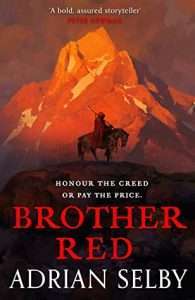 When Driwna Marghoster defends a trade caravan from a bandit attack at the start of Brother Red, everything appears business as usual for the Post soldier. That is, until a hidden corpse is discovered amongst one of the wagons. The Post, a merchant guild with a strict creed, does not deal in trading flesh. Curiouser still, the body belongs to the rarely-sighted Oskoro people, whose presence cultivates mysticism and lore. As Driwna begins to unravel the mystery, she treads a path well-worn in deceit, corruption, and pain to something altogether more terrifying than she could have conceived possible.
When Driwna Marghoster defends a trade caravan from a bandit attack at the start of Brother Red, everything appears business as usual for the Post soldier. That is, until a hidden corpse is discovered amongst one of the wagons. The Post, a merchant guild with a strict creed, does not deal in trading flesh. Curiouser still, the body belongs to the rarely-sighted Oskoro people, whose presence cultivates mysticism and lore. As Driwna begins to unravel the mystery, she treads a path well-worn in deceit, corruption, and pain to something altogether more terrifying than she could have conceived possible.
Brother Red once again shows Selby’s strength with action sequences: the buildup of tension, the pacing, and the way he describes what’s happening blend seamlessly together, creating a visceral experience. Through Driwna’s perspective, we experience his unique affinity for magic systems and lore. The structure of the book lends itself to the plot. The story ebbs and flows as Driwna makes connections in a natural way, keeping a solid pace throughout.
Where some readers might be surprised is with the shift in Selby’s focus with respect to the story elements. As opposed to his previous works, which are heavily character-driven, Brother Red centers more on the plot, building other aspects of the novel like characters, setting, and themes around it. Selby’s voice and prose are also more polished; his ability to say something impactful in a direct and concise sentence pairs well with other emotion-filled paragraphs.
Grimdark fans will appreciate Selby’s balance of brutal violence and hope in the backdrop of a politically-corrupt setting. Behind every character’s choice is their own reason. As Driwna is forced to accept these reasons for what they are, the reader will also be reminded of the differing perspectives that situations will inevitably create: “Bad decisions are made for what would seem to be good reasons, and these decisions may be hidden for what may seem to also be good reasons” (60).
Though all three of Selby’s works are standalones set in the same world, I would recommend reading The Winter Road before Brother Red. Selby’s unexpected connections between the stories add to the already layered plot and narrative, enhancing the experience in a positive way.
Read Brother Red by Adrian SelbyThe post REVIEW: Brother Red by Adrian Selby appeared first on Grimdark Magazine.
June 28, 2022
REVIEW: The Evil Within 2
The Evil Within 2 (2017) is the sequel to, unsurprisingly, The Evil Within (2014) and a game I picked up immediately after finishing the first game. I probably should have played the DLC for the first game before I played this but I’m not a big fan of stealth in video games and those are the primary mechanic of the original expansion. So, what did I think of The Evil Within 2? A game that was following up to a game with a lot of ups and downs? Well, it is a lot more consistent experience but not really a better one.
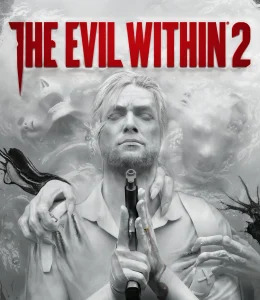 The premise is Sebastian Castellanos, protagonist of the first game, has been fired from the Krimson City police department after explaining the events of the first game. Which were, if you didn’t play the game, a psychopathic Freddy Krueger wannabe named Ruvik using a wireless Matrix to plunge dozens of people into a hellish nightmare world called STEM. Sebastian has very little to live for as he also lost his little girl to a fire and his wife to what seemed like a paranoid conspiracy theory about a group called Mobius.
The premise is Sebastian Castellanos, protagonist of the first game, has been fired from the Krimson City police department after explaining the events of the first game. Which were, if you didn’t play the game, a psychopathic Freddy Krueger wannabe named Ruvik using a wireless Matrix to plunge dozens of people into a hellish nightmare world called STEM. Sebastian has very little to live for as he also lost his little girl to a fire and his wife to what seemed like a paranoid conspiracy theory about a group called Mobius.
Well, it turns out Mobius is real and recruit Sebastian by force to go into their new version of the Matrix, err, I mean STEM. Sebastian has a reason to cooperate, though, in that his daughter is alive and the “core” of the new machine. Mobius has created a replica of a small American town in their virtual world but, unfortunately, it has started turning into the same sort of hellscape that the Beacon Mental Hospital from the first game became. Which in gamer terms, means the townsfolk are all becoming zombies or worse.
The biggest pros of The Evil Within 2 are that it is a much-much better designed experience in terms of gameplay. The stealth mechanics are much better, the skill system has been pruned down to a more manageable level, a crafting system has been created that functions well (especially when you’re in need of ammo), and a bunch of other things that make the experience more streamlined. The combat is also a good deal easier, which isn’t necessarily saying its better but it’s no longer frustratingly difficult either.
The story is also a great deal simpler and easier to understand but, unfortunately, derivative. Sebastian wants to save his daughter, and this is something that it is about as common as “save the Princess” these days. Sebastian even looks like Joel from The Last of Us now. Given I’d only recently played Resident Evil: Village, I can’t say that there weren’t a lot of similarities there too. On the other hand, it’s a decent motive and it isn’t a mistake after the overly convoluted weirdness of The Evil Within.
I also give credit for the games’ two bosses with Stefano and Father Theodore. While it seems a bit silly that two more serial killers are put into STEM after Ruvik, they were both exceptionally realized baddies. Stefano more than Theodore, who is just your standard “burn the witch” evil priest, which is strange since he doesn’t appear to actually be religious. Stefano, by contrast, is an evil photographer who likes creating murder art. There’s some genuinely creepy monsters that accompany him like the Obscura and I got scared a few times during his segments.
Unfortunately, the biggest problem with the game is that aside from Stefano’s sections and the optional Anima sidequests, the game just isn’t nearly as creepy or frightening as the original. Beacon Hospital was more gory than scary, but it was a visual treat even when it wasn’t terrifying. Union just feels like a somewhat bland middle American town with monsters and is far inferior to Beacon Mental Hospital as a setting. While a couple of the bosses are frightening, none of them match up to the original games’ baddies. There’s even a section of the game where you fight the bosses of the first game, and they sort of blow the rest of it away.
The lack of Ruvik is also a big problem with the game. This is a game that doesn’t necessarily need Ruvik and I liked the psychopaths here, but they could have made much better use of him. We also never actually get a reason why the town of Union becomes the hellish nightmare-scape it does. Is it because your daughter is dead, is it because Ruvik “infected” STEM permanently, or is it because of all the other psychopaths present? The Administrator just isn’t intimidating enough to be the main baddie and I feel like they could have done more or had a big Ganon-esque reveal ay the end that Ruvik was possessing your daughter or something.
The game also half-measures its supposed wide-open sandbox. Despite the fact the town of Union is supposedly open for exploration, it’s actually cordoned off into tiny little areas that you can only progress through using “The Marrows” which amount to the backstage of the Matrix. I feel the game should have committed to either a wide-open sandbox for Sebastian to explore or just kept with the linearity of the original game, which was fine. It doesn’t help you can also meet with multiple NPCs, but they keep dying before they can add much to the worldbuilding. I feel like the Kidman/Sebastian relationship was also underdeveloped when I was actually invested in it. Given Sebastian’s (ex)wife plays a big role in the game, perhaps that is for the best.
In conclusion, I rate The Evil Within 2 as “fine.” The gameplay is much better and the story slightly stronger but it’s significantly less weird and that is a flaw when doing a survival horror game. The monsters are less horrible and unnerving than the original game too. It also feels less like a grand guignol of blood pools, viscera, and other Silent Hill-esque horror. Blood and gore do not a good story, but they are fine party decorations for a Mature-rated game. This just feels like a tamer inferior sequel but not that inferior. I still recommend playing it. Just, you know, not if you have any other games you want to play instead.
Play The Evil Within 2The post REVIEW: The Evil Within 2 appeared first on Grimdark Magazine.
An Interview With Robert Jackson Bennett
Robert Jackson Bennett’s trilogy is a lot of things, a novel about pain and growth. Sancia is not the same character we started with. It is also about found families and the importance of relationships we make along the way in life. It is a novel about power, magic, and technology. But most of all Founder’s is ending. It has had a beautiful arc and we end with a kernel of hope. You can read the final installment of the Founders trilogy with this month’s release with Locklands.
Bennett was gracious enough to have a conversation with me about this trilogy, writing, and what he has going on in the near future.
 GdM: You have won or been nominated for various awards, including the Locus, Shirley Jackson, and World Fantasy awards. Was the writing process the same after a nomination or win? Or was the writing process different?
GdM: You have won or been nominated for various awards, including the Locus, Shirley Jackson, and World Fantasy awards. Was the writing process the same after a nomination or win? Or was the writing process different?
Ehhhhh, not really. I utterly lack all insight into how awards lists are generated and then how the awards themselves are then given out. I suspect each one functions in a completely different way, and that method changes hugely from year to year, based on the jurors. As such, trying to build a career around awards would be a little like trying to develop a daily routine on what color cars you see go by your house each morning.
GdM: You wrote that you get a lot of ideas about vacuuming; I get that. Vacuuming is meditative. Is it true you were vacuuming your living room and listening to St. Vincent’s “Digital Witness” when you came up with the idea for Foundryside? What about City of Stairs or Vigilance?
Kind of. I listen to music to try to capture mood: the ambience, the vibes. I definitely have songs that are tied to specific scenes, and I used to try to summarize them on my blog. (Example.)
However, having reviewed the traffic on those blog posts, I quickly came to the conclusion that ain’t nobody give a fuck about that stuff, so I gave up and keep that to myself now.
People want to see maps and drawings, stuff like that. Nobody cares about your mixtape. It’s a humbling realization.
GdM: Your early work and some of your short fiction has a strong horror element. Do you plan on returning to that kind of work in future projects?
Nope! I like dollars. I get to buy food with those things. Unfortunately, people are unwilling to exchange dollars for short fiction. Hell, people already get pissed off and yell at me on twitter because they gotta pay a couple dollars for this thing I spent three, four years making. I bet most people would only buy short fiction for a handful of bottlecaps and a small bag of dirt.
GdM: What attracts you to the horror genre? What attracts you to fantasy?
People like the idea of a world that’s bigger than you. They like the feeling that there’s more out there, that this isn’t all there is.
What’s more interesting is to flip that around and explore the crawling suspicion we all share: what if the world is bigger and more fantastical and alive than we think, but it doesn’t give a shit about us? What if we’re just bugs to it? Or what if it’s actively hostile to us?
I like fantasy for the same reason. For some folks, fantasy is a power trip, an imaginary world where you can shoot fire from your hands. For me, it’s about that weird feeling of being small in a big world.
GdM: Do you read horror? If so, what kind of horror do you find scary as a reader?
Not really! I mostly stick to nonfiction these days. That stuff has no shortage of horrors, but they’re all bland and mundane and terrifyingly easy to imagine happening again. Nobody wants to read a fantasy novel about the Holodomor.
GdM: Along those same lines, your early work also touched on lots of Americana. What was it about this that fascinated you?
Well, I live in America. I keep all my stuff there.
I guess I felt like in the 2010s we were trying to figure out a national identity of who we were, and I wanted to reflect on that conversation. However, now we are all just screaming at each other and trying to kill each other, and I have less to say about such an exchange.
GdM: You’ve mentioned Le Carre as an inspiration for The Divine Cities. Who would be the big one for The Founders trilogy?
Probably Terry Pratchett. Pratchett was always secretly a science fiction writer, anyways. You could feel all the big ideas and complex systems bleeding into his works. I wanted to do that, but in my own way.
It was that, and the classic science fiction films I watched as a kid. When I was younger, you usually watched science fiction and read fantasy. I’m not sure why it worked out that way. But I remember watching Blade Runner when I was around ten, and feeling this intense, beatific melancholy at the idea of identity merging with technology, and how the wonders of science didn’t make it any easier to just go about being a person every day.
I feel like the best cyberpunk stories touch on that melancholy: the sudden awareness that you are, in a way, a temporary system image of a person, like the imaging of a machine. But this one might not be one you can restore.
Another was the show Halt and Catch Fire. I respect how the show was willing to totally change locations and times from season to season. We see these people at different eras of their lives facing totally new issues. That was inspiring, and gutsy.
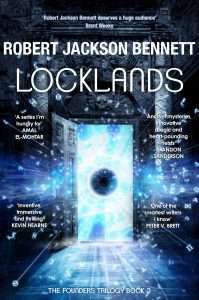 GdM: Can you tell us where we are in Locklands?
GdM: Can you tell us where we are in Locklands?
War has eaten the world, and Berenice and Sancia and their survivors are on the run. They’ve invented and invented and changed and changed, until they’ve built a little bubble of egalitarian utopia that challenges what it even means to be human anymore. They changed because they had to, and they’re starting to have a vision of a posthuman world they could found together – until they get some very bad news, and realize their enemy might have found a way to alter the world on a grander scale than they can imagine.
GdM: How has Sancia changed over the course of the three books?
I think Sancia very much reflects the arc of maturity, the growing conception of the world beyond you. She is both literally and figuratively forced to grow up very fast. I think many young people experience this arc, where you’re full of revolutionary fervor and insist that unless your ideals are adopted by the world at large, the world will cease to be; but then the world keeps on going, maybe picking up some of your ideals or maybe not, and you start to comprehend the macro level systems that are shaping your choices and life as you live it.
I think some fans would have preferred I keep with the revolutionary spirit – but most revolutions fail. And most young people who fight in them get killed on the front lines, or get rounded up and shot. That’s how history shakes out. And I think in Locklands, she knows that.
Sancia is not quite the protagonist of Locklands, because by this point, she’s too wise to be a protagonist. Your protagonist has to be dumb enough to try some really dumb shit for the book to be entertaining. But Sancia, by this point in the series, is too smart to be that stupid. She sees the arc of her story, and the story of her people, and is content to live it – including its end.
GdM: What’s the scene from Locklands you’re proudest of?
I would say the very, very end. That, or a moment where Berenice has a memorial for someone who’s now gone. You learn a lot about her, and what she’s going through.
GdM: The Divine Cities is a trilogy that started as a standalone. The Founders was a trilogy from the beginning. What was the difference in writing those stories?
I think the tricky thing is that as an audience member, I want the stories of the characters to be fully resolved in each installment. I want things to have closure. I don’t want to have to open wounds back up and mess with them more – yet this is what the series demands of you.
So that’s the balance you have to strike: the idea that each installment of a series is like an era of a life, where you face issues and struggle to resolve them. (There are series out there whose installments offer no closure and just kind of stop, and I think they suck.) But just like in real life, things aren’t truly closed, but just somewhat resolved – and yet, the world keeps going, with all its disappointments and worries.
I think that’s how the best sagas work. They are aware of the flow of time, and understand how time doesn’t respect how you feel about the eras of your life. It just keeps ticking on, and it’s all too content to reopen old wounds.
GdM: Now that you are ending the trilogy, did the story end how you envisioned it?
Actually, yeah! The last scenes are ones I wrote in my head way back in… hell, 2015? 2016? It felt deeply, deeply strange to write them in 2021. It was like time traveling: looking through glass and seeing your younger self sliding by, unaware that your older self is sharing this moment with you.
GdM: I found that the political dynamics of power in The Founders in a society based on intellectual property were written very well. Did you research this topic before writing the novels, or were the power struggles dynamics evident to you from the start?
Nope! I just figured that was how shit would shake out. Maybe part of it was how I’d listened to news stories long ago about how algorithms were patented, these complex mathematical and logic puzzles that were inscrutable to most people, yet were now bound up in laws, protected by the justice system. It did feel like magic.
GdM: What is next for you?
I’m gonna shoot from the hip, and say you might be seeing me do the high fantasy equivalent of Knives Out.
Read The Foundry TrilogyThe post An Interview With Robert Jackson Bennett appeared first on Grimdark Magazine.
June 27, 2022
REVIEW: Red Sister by Mark Lawrence
Red Sister is a classic of modern fantasy, a perfectly crafted and beautifully written opening to Mark Lawrence’s Book of the Ancestor trilogy, which centers on a cast of young novices training to become skilled warriors, spies, alchemists, and mystics under the tutelage of Abbess Glass and the sisters of Sweet Mercy Convent.
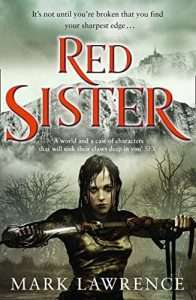 It all begins with a young peasant girl, Nona Grey, an outcast from her small village in the brutal ice-covered world of Abeth. Only a slim corridor of green encircles the planet, kept alive by a mechanical moon that focuses light from a dying sun. The moon was created by the Missing, the original settlers of Abeth who possessed technology now lost to the current population. But traces of the four original tribes remain in their blood, giving heightened powers to a select few. Nona is one of the very rare individuals exhibiting traits from more than one of these original tribes.
It all begins with a young peasant girl, Nona Grey, an outcast from her small village in the brutal ice-covered world of Abeth. Only a slim corridor of green encircles the planet, kept alive by a mechanical moon that focuses light from a dying sun. The moon was created by the Missing, the original settlers of Abeth who possessed technology now lost to the current population. But traces of the four original tribes remain in their blood, giving heightened powers to a select few. Nona is one of the very rare individuals exhibiting traits from more than one of these original tribes.
The four tribes, in order of decreasing prevalence, are: (1) gerant, who grow to an abnormally large size; (2) hunska, who can move and react with fantastic speed; (3) marjal, who have access to the lesser magics, including shadow-work and mastery of the elements; and (4) quantal, who can access an alternate layer of existence known as the Path, enabling them to manipulate the threads of reality itself and form entangled bonds with the minds and bodies of other quantals. Children who exhibit traits of the original tribes are often captured and sold into fight-halls. The lucky ones find their way to Sweet Mercy Convent, where they can be trained to control and develop their powers.
The worldbuilding in Red Sister is outstanding, with careful consideration for all factors related to the geography, technology, religion, politics, and culture on a planet where only a small strip of land is inhabitable. Whoever controls the mechanical moon also has the fate of the entire world in their hands.
Best of all are the characters. Red Sister introduces us to Mark Lawrence’s most compelling cast of characters from any of his series. Nona Grey is an ideal main character, struggling with the dark realities of her past and her seemingly uncontrollable violent powers. But at her core, Nona is a very kind and caring person who values honesty and friendship above all. The other novices—Ara, Zole, Clera, Hessa, Juli, et al.—are all wonderfully developed characters, as are the sisters of Sweet Mercy.
Mark Lawrence’s writing is concise but packed with details and emotional value, without ever wasting space on filler. There are so many quotable lines throughout Red Sister, including its iconic opening: “It is important, when killing a nun, to ensure that you bring an army of sufficient size.”
I especially appreciate Mark Lawrence’s attention to detail and the way he gradually reveals the truth about certain characters. Nona’s violent and heart-wrenching past is revealed after several misdirections, including her interactions with the peripatetic juggler, Amondo, and the way she saves her friend, Saida, from the brutal gerant Raymel Tacsis. We also learn about Clera’s true backstory as the copper penny she flips gradually changes to silver and then to gold over the course of the book. I also love how Mark Lawrence plays with classic fantasy tropes, such as the magic school and the notion of a Chosen One.
I really can’t recommend this series enough. With the Book of the Ancestor, Mark Lawrence has crafted the perfect fantasy trilogy, and I don’t give that praise lightly. I’ve read the series several times, and it keeps getting better each time through. Upon my first read of Red Sister, I already fell in love with the wonderful cast of characters and was blown away by the story itself. However, each time through, new layers emerged with subtle foreshadowing of future volumes in the Book of the Ancestor trilogy and Mark Lawrence’s subsequent series, the Book of the Ice.
Clever connections to Lawrence’s other trilogies also gradually reveal themselves upon careful reading. For example, those with gerant blood share a name with the abnormally large knight Sir Gerrant, who is mentioned briefly in both Prince of Thorns and Prince of Fools. In fact, the characteristics of each of the four tribes in Red Sister are connected to Mark Lawrence’s broader worldbuilding across his five trilogies, but only hinted at throughout the Book of the Ancestor.
I would advise readers who finish Red Sister to read Mark Lawrence’s excellent short story, “The Devil You Know,” before continuing to Grey Sister. You can think of “The Devil You Know” as a few extra chapters tacked onto the end of Red Sister, describing the aftermath of the final scene from that book and providing an important bridge to Grey Sister. Astute readers will also find subtle connections among all of Mark Lawrence’s trilogies buried in this short story.
When I finished the Book of the Ancestor trilogy, I was left hungry for more in this world of Abeth. Fortunately, Mark Lawrence’s next trilogy, the Book of the Ice, takes place in this same world. The Book of the Ice greatly expands the breadth and depth of worldbuilding on Abeth and also solidifies the connections to Lawrence’s greater universe. The third volume of the Book of the Ice, The Girl and the Moon, reads essentially like a fourth Book of the Ancestor and prominently features one of my favorite characters from that series, Sister Pan, a powerful quantal who serves as Mistress Path in Red Sister.
Five enthusiastic stars to Mark Lawrence for Red Sister, one of his finest achievements. If you haven’t already started Book of the Ancestor, pick up a copy of Red Sister today, and Nona Grey will become your friend for life.
5/5
Read Red Sister by Mark LawrenceThe post REVIEW: Red Sister by Mark Lawrence appeared first on Grimdark Magazine.
June 26, 2022
REVIEW: Disco Elysium
The flippant pitch for Disco Elysium would be to say if China Mieville wrote a Dirk Gently video game. The writer, Robert Kurvitz, has made something unique with this game, and it’s hardly a surprise to see it has won as many awards as it has.
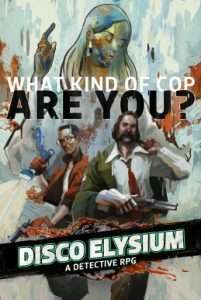 In Disco Elysium, you play a terrible cop trying to solve a terrible case. When you wake up hungover at the start of the game, you’ve lost your badge, your gun, and your car. You’ve got voices in your head that double as your skills, and they’re a far cry from the ones found in most games. Sure, you’ve got Perception and Hand-Eye Coordination, but you’ve also got Esprit de Corps, Shivers, and Half-Light.
In Disco Elysium, you play a terrible cop trying to solve a terrible case. When you wake up hungover at the start of the game, you’ve lost your badge, your gun, and your car. You’ve got voices in your head that double as your skills, and they’re a far cry from the ones found in most games. Sure, you’ve got Perception and Hand-Eye Coordination, but you’ve also got Esprit de Corps, Shivers, and Half-Light.
These voices argue with you (and each other) and when you fail a task they’re as likely as the NPCs to mock you. You start the game really far behind where you need to be, and as the game goes on it becomes apparent—this is entirely because you messed up prior to the start of the game.
A man was killed, and you’re supposed to bring the killer to justice. The man who was killed was a mercenary caught up between two sides of a major labour dispute. He’s been hanging from a nearby tree for days, with a neighborhood kid chucking rocks at his corpse for fun.
The side quests range from standard to ludicrous to brilliant. My favorite was getting some young people to open up a rave in a church that a crab-man lived inside, while also convincing the scientist who was in the church studying the silence from a 2mm hole of nothingness that she should go along with it. Even the standard one was good, decent detective work, solving a missing persons case and telling the victim’s family.
The NPCs are great, even the ones you dislike. They have strong, distinct personalities, while still being recognizably a part of the city and the system that made them.
The game is an isometric CRPG, designed similar to Planescape: Torment, but it doesn’t even have PS:T’s rare combat. It’s a murder mystery through and through. Instead, when you do a skill check it’s based off your skills, and any relevant bonuses or penalties you might have. There are white checks, which can be retried when you level up that skill, and red checks which cannot (but no failure on a red check ever prevents the plot from moving forward.)
The game puts up obstacles for min-maxing as well. If you have too many points in a skill, it’s entirely possible that you’ll overdo it and fail in a different way. Authority, for example, will make some trust you or at least accept what you’re saying, but too much will make others close up to you.
Responding in similar ways enough to different NPCs can also open up options for your character to go from being a cop to being a Superstar Cop, an Apocalypse Cop, a Sorry Cop, and more. There are also philosophies you can fall into which have their own quests, so if you argue about moralism or ultraliberalism or communism you can open up different plot-lines.
The history of the world was fleshed out well. Robert Kurvitz had made it for a tabletop RPG, and then it was the setting for a book he wrote called Sacred and Terrible Air that has, unfortunately, never been translated into English. But the various strains of thought, the long and revolutionary history, the historical context for different iconography, the streets still filled with war-torn fragments, and the strange energy called The Pale all pushed together in this game to make the setting seem truly lived in, depressing but just fantastical enough to spark imagination.
Play Disco ElysiumThe post REVIEW: Disco Elysium appeared first on Grimdark Magazine.
REVIEW: Prince of Fools by Mark Lawrence
Every magnet has two poles, north and south, which can never be separated. The power of the magnet—indeed, the very concept of a magnet itself—necessitates a pairing of these two opposite but complementary poles. In Prince of Fools, author Mark Lawrence has personified this concept of inseparable magnetic poles with Jalan Kendeth, the fun-loving playboy prince from the southern part of the Broken Empire, and Snorri ver Snagason, the serious and honest Viking from the north.
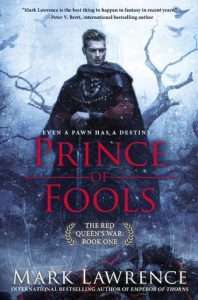 Prince Jalan is a self-admitted coward, liar, and cheat. He wants to live the good life of a royal who is tenth in line to the crown, full of wine, women, and gambling. Responsibility is overrated.
Prince Jalan is a self-admitted coward, liar, and cheat. He wants to live the good life of a royal who is tenth in line to the crown, full of wine, women, and gambling. Responsibility is overrated.
But fate deals Jalan a different hand when he meets Snorri, a hulking Norseman who has been captured and sold into slavery. Jalan and Snorri become bound together through a magic spell cast by the Silent Sister, the mysterious sibling of the Red Queen, Jalan’s grandmother, whom only Jalan and Snorri are able to see.
Jalan and Snorri set off together to the icy lands of the North on a quest that neither of them fully understands. As part of the Silent Sister’s spell, one becomes dark-sworn and the other light-sworn, two complementary forces representing the yin and yang of their relationship. Although the forces of dark and light appear as opposites, they are actually interdependent, a lesson that Jalan will need to learn throughout his journey with Snorri.
Prince of Fools is the first volume of the Red Queen’s War trilogy, which takes place in the same neo-feudal, post-apocalyptic world as Prince of Thorns and the rest of Mark Lawrence’s Broken Empire series. Utilizing the perspective of Jalan Kendeth, Lawrence has crafted a very different experience in this same dark world.
The tone of Prince of Fools is more lighthearted compared to that of Prince of Thorns, primarily due to having Jalan as narrator. Despite his many shortcomings, Jalan is a good person with a self-deprecating sense of humor. I laughed out loud several times while reading Prince of Fools.
I love the friendship that develops gradually between Jalan and Snorri, a perfect odd couple who play well off each other throughout the trilogy. Snorri always believes the best in Jalan, despite Jalan continually trying to cut himself down.
The intersecting plotlines between Prince of Fools and Prince of Thorns are another highlight. Both novels take place concurrently, and there are several overlapping characters, including the enigmatic Dr. Elias Taproot. I was particularly amused seeing Jalan’s perspective on Jorg Ancrath and his band of Road Brothers from Prince of Thorns, including one of them who is harboring a surprising secret.
Although I am emphasizing the more lighthearted elements of Prince of Fools, this is still grimdark fantasy full of violent action (cue Snorri picking out pieces of lung from his overgrown beard). Jalan Kendeth is a morally gray narrator, but much more immediately likeable than Jorg Ancrath in Prince of Thorns.
Which trilogy should be read first? There is no wrong answer to this question, since the Broken Empire and Red Queen’s War trilogies can be read in either order and provide complementary perspectives on the same world. If you want to turn the grimdark dial up to eleven, then Prince of Thorns is the better place to start. However, readers who are not yet ready to dive into the pitch-black heart of Jorg Ancrath may find Prince of Fools to be a better entry point to Mark Lawrence’s world of the Broken Empire. Prince of Fools also has a more accessible writing style and linear narrative structure compared to Prince of Thorns, making it an easier read. Overall, the Red Queen’s War trilogy also offers more expansive worldbuilding compared to the Broken Empire trilogy.
On the other hand, each book of the Red Queen’s War has a scene that overlaps with the corresponding volume of the Broken Empire trilogy, and I think readers will enjoy those scenes more if they already know the context from the Broken Empire. Regardless of which series you read first, I highly recommend both the Broken Empire and Red Queen’s War trilogies.
Overall, I’ve never had such a good time in a post-apocalyptic world as I did in Mark Lawrence’s Prince of Fools. Lawrence has created a gleefully fun and surprisingly complex main character in Jalan Kendeth, who provides a perfect balance to the dark world in which he inhabits.
5/5
Read Prince of Fools by Mark LawrenceThe post REVIEW: Prince of Fools by Mark Lawrence appeared first on Grimdark Magazine.

